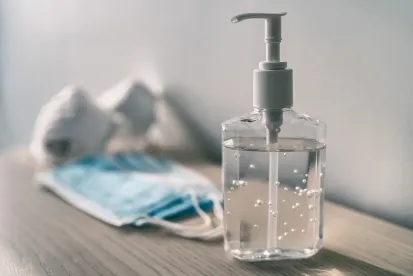The rapid emergence of COVID-19 — and the limited and diminishing supply of healthcare resources needed to treat patients and protect healthcare providers — has many public and private universities and other nonprofit institutions fielding urgent requests to manufacture or otherwise supply critical care medical devices and substances, replacement parts for medical devices, and personal protective equipment (“PPE”) for medical professionals. To fulfill these urgent requests, expediency may suggest that the institutions examine and perhaps mirror device designs or formulas that could be covered by third-party patents. The urgent nature of the requests, however, also may deny the institutions the usual time to assess the risk of patent, copyright, or product design infringement. While it may be tempting during these turbulent times to rely on intellectual property (“IP”) owners’ altruistic pledges to not enforce their IP rights,1 or find solace in the idea that no IP owner would pursue enforcement for fear of public backlash, universities and other institutions engaged to do this emergency work still need to be mindful of potential infringement risks.
To help manage those risks, the following checklist provides strategies that universities and nonprofit institutions may use to assess and seek to mitigate the risk of infringement:2
-
Due Diligence: Before entering into a rush supply contract, an institution should still exercise appropriate, if abbreviated, due diligence. Although the emergency nature of the project may limit the extent of an institution’s efforts, there may be time to perform, on a limited or high-level basis, due diligence through: (1) an IP clearance study, (2) research into the IP asserted in the relevant technical area, or (3) requiring the requesting party to supply all information it possesses about relevant IP and infringement risks. Even limited due diligence may identify key features to avoid to mitigate risk. Also, if key, potentially blocking IP is identified, the pressure of the current public health crisis may justify favorable license terms for products produced to address these unique demands.
-
Indemnification Terms in the Supply Contract: Institutions also may seek to shift the risk of an infringement action to the requesting party by obtaining indemnification, including the duties to defend all infringement claims and to indemnify the institution in the event of an adverse judgment. If the solvency of the requesting party is unclear or dubious, the institution might ask the requesting party for proof of its ability to defend and indemnify. If the parties agree to indemnification, the institution might ask the indemnitor to post a bond or other security to assure adequate reimbursement. Alternatively, institutions may require the requesting party carry liability insurance capable of covering all costs arising from an infringement action.
-
Insurance: Institutions engaged in these supply efforts might also seek to purchase IP insurance. Although historically such insurance is expensive or hard to find, the insurance market is dynamic and new options may be available.3 Universities and institutions relying on such insurance should review any potential policy with an experienced IP litigator and coverage counsel before purchase.
-
Representations and/or Warranties in the Contract: Institutional suppliers also can request representations and warranties from the requesting party stating that there is no risk or known risk of infringement. In conjunction with its own abbreviated due diligence, the institution may also ask the requesting party to certify that it has conducted sufficient investigation and due diligence and found no infringement issues. Similarly, an institution asked to make or design a product or system should insert terms that seek to insulate it from liability, such as by specifying that it makes no warranty that products or systems using its design are free from infringement claims and that it will not defend or indemnify the requesting party or anyone who uses the product or system.
-
Eleventh Amendment and Sovereign Immunity: State universities and institutions may enjoy sovereign immunity from patent infringement suits.4 Sovereign immunity bars adversarial proceedings brought by private parties against a state or — most relevant here — an arm of the state.5 Whether an institution is an arm of the state hinges upon the (1) “essential nature and effect of the proceeding” and the (2) “nature of the entity created by state law.”6 Institutions considered arms of the state, however, must be careful not to waive their Eleventh Amendment privileges and thereby expose themselves to lawsuits.
-
28 U.S.C. § 1498: If asked to supply products by or for the federal government, both public and private institutions may seek refuge from an infringement suit under 28 U.S.C. § 1498. Under this statute, if the supplier to the government infringes a third party’s patent, the patent owner must sue the United States instead of the manufacturing supplier.7
-
The Bayh-Dole Act: Occasionally, individuals or entities acquire title to patents generated in whole or in part from federal agency funding. If an institution believes its conduct may infringe such a patent, the institution may ask the federal government to exercise its march-in rights.8 nder these rights, the funding federal agency may compel the patent holder to grant a license to the institution to use the patented invention.9 ederal agencies have the power to require such action for a number of reasons, including when “necessary to alleviate health or safety needs which are not reasonably satisfied by the contractor, assignee or their licensees[.]”10 though federal agencies have yet to exercise their march-in rights,11 the COVID-19 pandemic is not a typical situation and may force agencies to undertake unprecedented action.
-
Patent Pooling: Institutions may also seek collaborative solutions with patent owners, such as patent pooling. Under this type of arrangement, the patent holder could agree to transfer its rights to be pooled with others’ patents allowing the institution, at a minimum, to obtain a license for the patent on fair, reasonable, and nondiscriminatory terms.
-
Hatch-Waxman Act Immunity: Institutions may also be called to test or manufacture products requiring U.S. Food and Drug Administration (“FDA”) approval. If such action leads to potential patent infringement, the “safe harbor” provision of the Hatch-Waxman Act may immunize those acts from infringement suits if they are performed to support an application for FDA approval.12
Conclusion
While it may be tempting for a university or institution to rely on the humanitarian or public spirit of, or the risk of negative backlash to, a patent holder during the pandemic, the prudent course is to take a proactive approach to mitigate infringement risks. Employing any of the relevant strategies listed above may accomplish that goal.
NOTES:
[1] Mike LaSusa, Tech Titans Commit To Freeing IP To Aid Pandemic Response, LAW360 (Apr. 21, 2020), https://www.law360.com/articles/1265926/tech-titans-commit-to-freeing-ip-to-aid-pandemic-response; Britain Eakin, Businesses Urged To Make COVID-19 IP Free During Crisis, LAW360 (Mar. 30, 2020), https://www.law360.com/articles/1258436.
[2] The full scope and applicability of each strategy in this checklist is beyond the scope of this Alert. If a university or other institution believes any of these strategies may be applicable, the institution should consider seeking the guidance of qualified counsel to understand the strategy more fully before potentially implementing or relying on the strategy.
[3] AON, for example, offers various packages that cover “certain litigation expenses, settlements, and damages.” AON PLC, INTELLECTUAL PROPERTY LIABILITY INSURANCE SOLUTIONS (2018), https://www.aon.com/getmedia/c5dfff6e-e8d3-4426-a958-327dcdda601f/Intellectual-Property-Liability-Insurance-Brochure.aspx.
[4] See, e.g., Univ. of Utah v. Max-Planck-Gesellschaft Zur Forderung Der Wissenscaften E.V., 734 F.3d 1315, 1319 (Fed. Cir. 2013) (“[A] state university generally may not be sued for infringement, nor may it be forced to defend against an action for declaratory judgment of invalidity or non-infringement.”).
[5] Fed. Mar. Comm’n v. S.C. Ports Auth., 535 U.S. 743, 751–52 (2002).
[6] Regents of the Univ. of Cal. v. Doe, 519 U.S. 425, 429 (1997).
[7] 28 U.S.C. § 1498(a).
[8] 35 U.S.C. § 203(a).
[9] Id.
[10] Id. § 203(a)(2).
[11] Alan S. Gutterman, Business Transactions § 209:22, WESTLAW (Apr. 2020), https://1.next.westlaw.com/Document/I33c7c0963d2811e0b13e817f061d3d9b/View/FullText.html?listSource=Foldering&originationContext=clientid&transitionType=MyResearchHistoryItem&contextData=%28oc.Search%29&VR=3.0&RS=cblt1.0.
[12] 35 U.S.C. § 271(e)(1).







 />i
/>i

